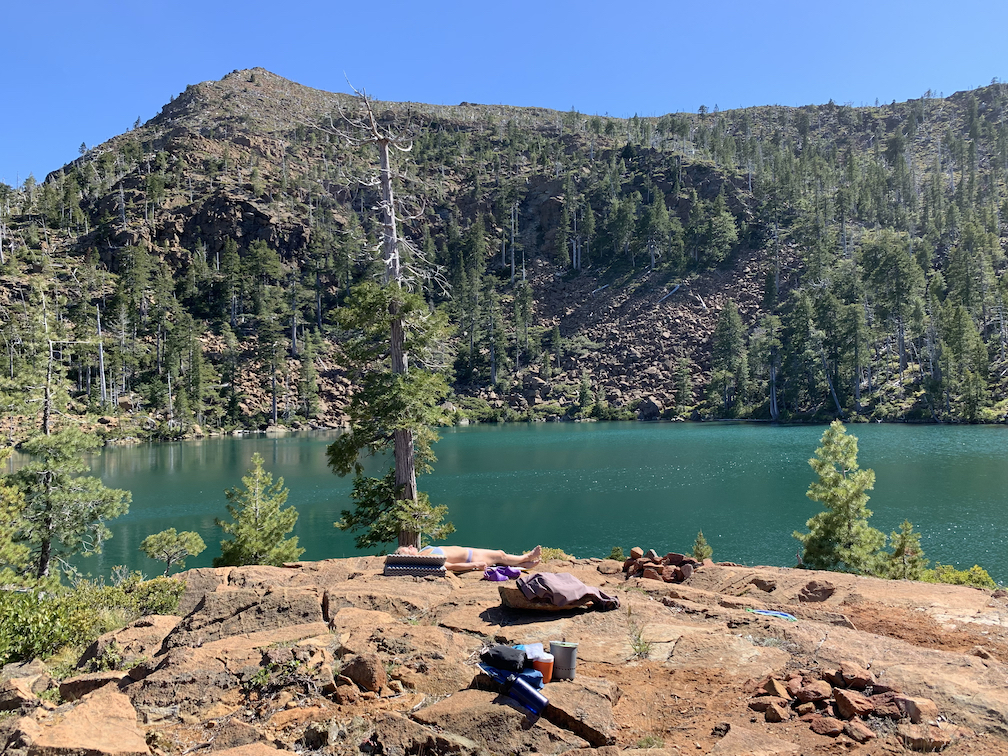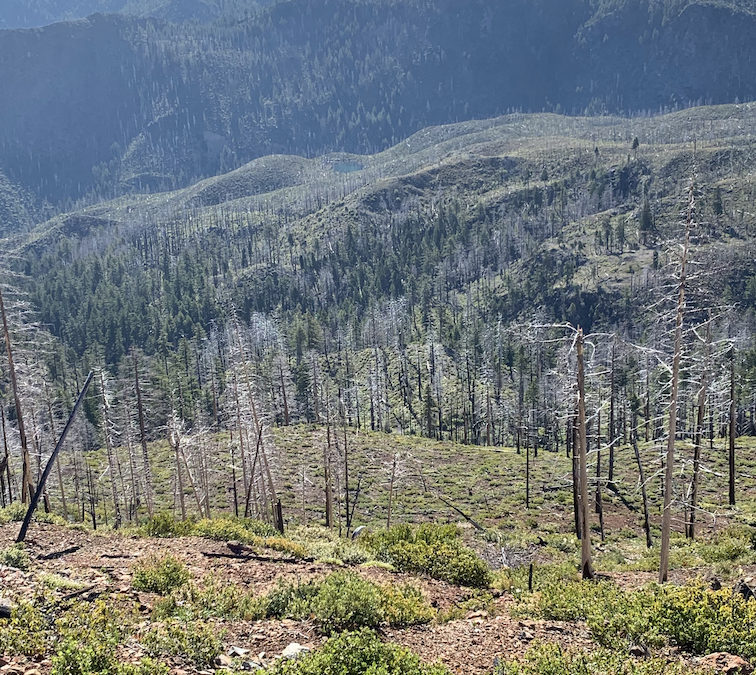A friend and I recently completed a four day, 55-mile backpacking trip in the Kalmiopsis Wilderness in southern Oregon. I ‘ve been on many backpacking trips and each one of them has presented challenges. The Kalmiopsis was no exception.
The US Congress designated the Kalmiopsis Wilderness in 1964. It covers 180,000 acres. The wilderness includes the headwater basin of the Chetco and North Fork Smith rivers and a section of the Illinois river canyon. The high point is Pearsoll Peak at just under 5,100 feet. The area was named after the Kalmiopsis leachiana, a pre-ice age plant that was discovered in the Gold Basin area in 1930. The region was mined for gold and other minerals for decades starting in the late 1800s.
Fire has been a part of the Kalmiopsis ecosystem for hundreds, probably thousands, of years. It burned in the Biscuit (2002), Chetco Bar (2017) and Klondike (2018) fires. The area hasn’t recovered from these fires, and we did most of our hiking on trails that ran through landscapes with ground vegetation, but missing the tall trees that once stood there.
We started our adventure at the Babyfoot Lake Trailhead on the eastern edge of the wilderness. We drove down from Portland and got started just after lunch. Our plan was to cover about 11 miles before camping for the night. It quickly became apparent that water would be an issue. While it was only June and this spring had been rather wet in the region, we found very few sources of water. We had been advised to camp at Doe Gap. But we started to realize that there would likely be no water at this location. With the day wearing on, we decided to leave the trail and bushwhack our way to a tiny lake.

As we were setting up our tent, I heard sounds several hundred feet away that I couldn’t identify, but suspected were from a bear. It was unnerving, as we were totally alone, and we hadn’t brought anything for self-defense. We filled our water bottles, took a dip in the lake, had dinner, and watched the sun drift toward the horizon. Just before dusk we put our food in a wire mesh bag and strung it up a nearby tree, and went to bed. I continued to hear the strange animal noises, but eventually drifted off to sleep.
The next day we packed up and bushwhacked our way back onto our trail, and then headed toward Vulcan Lake. We made sure we had plenty of water, and enjoyed a long (14 miles) day of hiking under blue skies. We were able to see the Pacific Ocean and even saw the surf near Gold Beach. We hiked up to Vulcan Peak, where we had planned to camp. But there was no trail from the peak down to the lake. So, once again, we had to bushwhack. The terrain was very steep and rocky, so we had to take great care while carrying our heavy backpacks. We reached the beautiful alpine lake and enjoyed a wonderful late afternoon of swimming in the clear water and sunbathing on the rock slabs above the water.

We got up the next day and decided that we’d need to change our plans to make our fourth and last day more manageable. We wanted to camp at Taggarts Bar, a beautiful open area on the Chetco River and the site of an old mining operation. But we realized we needed to cover more ground. So, we pushed on, hiked a total of 16 miles, and set up camp at Slide Creek. We arrived in the early evening, greeted by voracious mosquitoes. After filling up our water bottles, taking a bath in the river and eating a quick dinner, we went to bed.
We woke up early on our last day, had a quick breakfast and drank as much water as we could. We didn’t expect to have access to water until we reached Babyfoot Lake again. The climb out of the Chetco River valley was steep and long. We gained over 2,000 feet in just a few miles. There was no cover, and the sun was baking even early in the morning. We hiked another 14 miles back to the trailhead, where we learned it was 85 degrees.
What does backpacking have to do with investing? Well, there are some rather interesting parallels.
When you’re out in the wilderness, you need to manage your resources. It’s vital that you have a plan to access water. While it’s possible to go without food for days, backpackers need water, and lots of it.
Similarly, investors need to make sure they have enough money set aside to get through the kind of turbulent market cycle we’re currently experiencing. They need cash or other short-term, liquid investments. You don’t want to be forced into selling stocks when the market is down.
Backpackers navigate with a map, compass and/or GPS. I prefer the GPS, because it tells me exactly where I am. I can then refer to the map and quickly determine if I’m on (or off) route. Investors can figure out where they are, if they have a written plan built with robust modeling software. If the market is down, you can refer back your plan and determine if you’re still on track to meet your financial goals. If you don’t have a plan, it’s really hard to know where you or what you need to do.
Backpackers have to deal with weather changes. It’s certainly wise to start with an extended forecast for the area you’re visiting. But forecasts aren’t guarantees and mountain weather can change quickly. Backpackers need to be prepared for all kinds of weather (blazing heat, rain and even snow) at any time of the year. Likewise, investors need to be prepared for changes in the investment environment. Markets can change rapidly. Do you remember how quickly the market sold off in March 2020, after it became clear that COVID-19 would cause a global pandemic and basically shut down the economy?
Wilderness area are, well, wild. There are wild animals out there. I’m pretty sure we were close to a rather territorial bear on our first night in the Kalmiopsis. Backpackers need to be ready for whatever can happen in the wilderness. They could have an encounter with a mountain lion, a rattle snake, or a wolf. Attacks are rare, but they happen. Backpackers may have to navigate glacial water crossings, steep snow fields, downed timber, overgrown trails, and confusing signs. The reward for navigating these challenges is seeing breathtaking landscapes, breathing fresh air, drinking pure water, and sleeping under a dark sky filled with twinkling stars.
The markets can also be wild. Panics, manias, and crashes happen. In fact, they seem to happen about every 7 to 10 years. Do you remember Black Monday in October 1987? What about the “dot.com” Bubble in 2000? The Great Financial Crisis in 2007-2008? The Covid Crash in March 2020? All investors experienced significant unrealized losses during these events. For those who bailed out of the market and sold their investments, the losses became permanent. For those who held steady, the losses were temporary. The reward for remaining vigilant but patient during times of market tumult is long-term growth. Investors are eventually compensated for taking risk through capital gains, dividends, and coupon payments. The stock market’s average total return over time has been 9-10% per year.
Those who are new to backpacking should consider going with someone who’s experienced and who can teach them how to be safe and have fun in the wilderness. There are organizations that teach backpacking skills like NOLS, Outward Bound and REI. There are also professional guides who lead parties into the wilderness ( like World Expeditions, the Sierra Club and SYMG).
New or inexperienced investors should arguably also hire someone who can guide them. You can find qualified investment professionals at NAFPA, the CFP Board, and the SEC. Look for an investment advisor who is credentialed (a Certified Financial Planner™ or a Chartered Financial Analyst), experienced (10+ years) and skilled. Also make sure they’re a fiduciary.
If you don’t know what you’re doing, backpacking and investing can be frightening. But with the proper training (or the guidance of someone who’s trained and experienced), both can be very rewarding.
